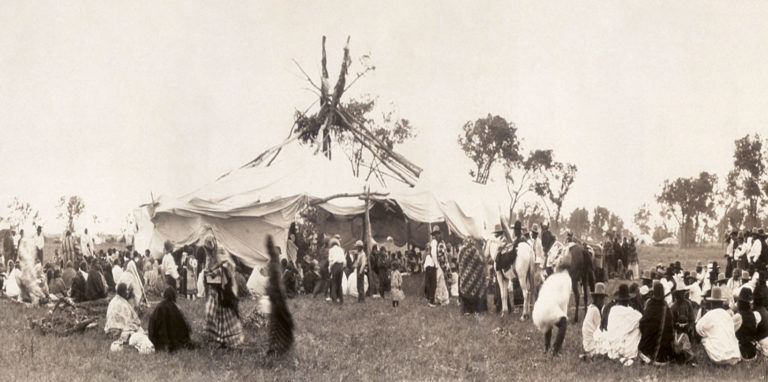In 1775-76, an Oglala war party traveling west from the Missouri River area came to the Black Hills. The Black Hills were occupied at that time by the Cheyenne, along with the Kiowa and Crow. But by 1794, after constant warfare, the Oglala and Brule controlled the Black Hills, allowing the Cheyenne to remain in the area as allies, while driving away other tribes.
The Indians in this area traded almost exclusively with the French until about 1817, when American traders began to compete for the buffalo fur business. In 1825, the U.S. sewed up the trade business with a treaty with the Oglala branch of the Teton (and in separate treaties with other tribes) centered around the American Fur Company trading post in eastern Wyoming.
In the 1840s, the increasing flow of emigrants to Oregon and California brought cholera, smallpox, and measles to the Indians as well as accelerated buffalo hunting. This caused hostility and some attacks against the emigrants and traders. In 1849, the U.S. military took over the fur trading post and renamed it Fort Laramie.
The 1851 Fort Laramie Treaty (a series of treaties with several tribes) was supposed to guarantee peace between the U.S. and many of the Indian tribes in a huge area east of the Rocky Mountains; all the way to Minnesota; and north of the Texas-New Mexico lines. (The Lakota were called the “Dahcotah” in the 1851 Treaty.) The Cheyenne, Crow, Arapahoe, and other tribes were also involved in this agreement, with individual territories assigned to them.
The 1851 Treaty was only a temporary pause in the ongoing conflict between the Indian tribes and continued American travel through Indian lands. Skirmishes and attacks occurred between Indians and settlers throughout the 1850s into the 1860s, especially in Minnesota, Colorado, Nebraska, Wyoming, and Montana. The Crow had been assigned the Powder River Basin and Bighorn Mountain area in the 1851 Treaty, but from 1851-1862 the Lakota, in alliance with the Northern Cheyenne, conducted annual campaigns against the Crow, eventually cutting off their supplies. The Crow were driven out of Wyoming up into Montana; and eventually out of eastern Montana also, because of intertribal competition for the shrinking hunting grounds for buffalo.
Some of the Indians thought there should be no travel through their lands, and would attack any incursions, even civilian wagon trains heading for Oregon, which were permitted by the 1851 Treaty. This led to the U.S. providing military escorts to emigrants traveling to Oregon through the Powder River Basin (from the Black Hills on the east, to the Bighorn Mountains in Wyoming on the west) and resulted in battles between the Indians, the U.S. military, and the emigrants.
Often American civilians turned north in central Wyoming toward the gold fields in Montana (the Bozeman Trail). This was a clear violation of the 1851 Treaty as understood by the Indians, although such inroads were allowed (as understood by the U.S.) by the written Treaty (Article 2). The Lakota and Cheyenne gathered their forces in March and April of 1865 for attacks against every white settlement, steamboat, stagecoach, and emigrant wagon train (civilians as well as military personnel) that invaded their territory. The U.S. government and military responded with more troops.
Keep reading: Native American Culture and the Black Hills 1865-1873

